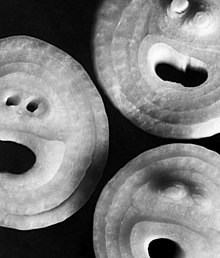
The Neues Sehen, also known as New Vision or Neue Optik, was a movement, not specifically restricted to photography, which was developed in the 1920s. The movement was directly related to the principles of the Bauhaus. Neues Sehen considered photography to be an autonomous artistic practice with its own laws of composition and lighting, through which the lens of the camera becomes a second eye for looking at the world. This way of seeing was based on the use of unexpected framings, the search for contrast in form and light, the use of high and low camera angles, etc.[1] The movement was contemporary with New Objectivity with which it shared a defence of photography as a specific medium of artistic expression, although Neues Sehen favoured experimentation and the use of technical means in photographic expression.
- ^ Moholy-Nagy, László, (1932) The new vision, from material to architecture. New York: Brewer, Warren & Putnam.